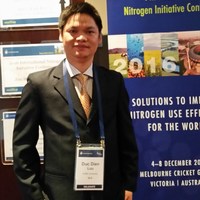Duc Dien Luu
Griffith University, Griffith School of the Environment, Graduate Student
- Researcheredit
Catfish (Pangasianodon hypophthalmus) farming along Mekong river and Bassac river depends heavily on water quality of the two rivers, whereas water quality of these rivers are affected by the waste of aquaculture activities, agricultural... more
Catfish (Pangasianodon hypophthalmus) farming along Mekong river and Bassac river depends heavily on water quality of the two rivers, whereas water quality of these rivers are affected by the waste of aquaculture activities, agricultural production, industrial and municipal waste. This report analyzes the monitoring data on Mekong river, Bassac river and adjacent waterways in the period of 2011-2012, focusing on parameters of organic pollution to assess the current quality of these two rivers. Based on the results, the water quality in the river-head was generally better than in the middle and at the end of the river, and the quality of water of the Mekong river was better than Bassac river. In terms of time, water quality in July was considered the best in all the basins. At adjacent natural rivers and canals, ammonia levels increased and exceeded the Vietnamese standard in April, and BOD values were also much higher compared to two major rivers. The results of the model also showed that the levels of pollution index of the Mekong and Bassac river were very low (1.33 and 1.47), and the values (Y) in the canals were higher (1.63-1.67) but still in permitted level. Therefore, the water quality of the Mekong and Bassac river in the period 2011-2012 was generally still quite good.
Saltwater intrusion has become a severe issue for the Mekong Delta in Vietnam, especially near the coastline. This issue has led to farmers diversifying from exclusively growing rice to adopting a mixed rice-shrimp system with rice only... more
Saltwater intrusion has become a severe issue for the Mekong Delta in Vietnam, especially near the coastline. This issue has led to farmers diversifying from exclusively growing rice to adopting a mixed rice-shrimp system with rice only cultivated in the wet season. However, the nutrient (nitrogen, phosphorus and carbon) cycling and nutrient use efficiency of this system remain poorly understood. To address this knowledge gap, we examined nutrient budgets across 12 farms using integrated rice-shrimp ponds, and in some cases semi-intensive or intensive shrimp grow-out ponds (Penaeus monodon or Penaeus vannamei), over a two-year period (2014-2015). In terms of nutrient budgets, the main nutrient input (92% of the N input, 57% P and 95% C) in the integrated rice-shrimp ponds (IRSPs) came from intake water (excluding C from primary production), while water discharge accounted for the highest output (75% of N output, 41% P, 57% C, excluding C from respiration). The study showed that IRSPs had low dissolved oxygen and high nutrient concentrations which may affect shrimp production. Conversely, salinity levels in the wet season were too high for rice plants thereby affecting rice production. Shrimp survival in the IRSPs was low over the two years (6.3 ± 2.2%), which resulted in the low proportion of nutrients exported from the ponds as harvested shrimp (6% N, 5% P and 10% C). In contrast, the shrimp grow-out ponds (SGOPs), had much higher survival (77.1% for P. vannamei and 59.2% for P. monodon) in three of the six farms where the shrimp survived through to harvest. In these ponds, formulated feed was the highest nutrient input (P. vannamei: 82% N, 75% P and 85% C; P. monodon: 75% N, 55% P and 77% C) with approximately a third of the nutrients being in the shrimp harvest. In our study, nutrients in the IRSPs were used less efficiently than in SGOPs, hence mechanisms to improve shrimp survival and production in IRSPs are urgently needed.
Saline water intrusion has become a severe issue facing the Mekong region of Vietnam, especially in coastal areas. This issue has resulted in farmers diversifying from growing exclusively rice to adopting integrated rice-shrimp culture... more
Saline water intrusion has become a severe issue facing the Mekong region of Vietnam, especially in coastal areas. This issue has resulted in farmers diversifying from growing exclusively rice to adopting integrated rice-shrimp culture systems. However, the nitrogen (N) cycling and N use efficiency of these systems remains poorly understood. To address this knowledge gap, we examined nutrient budgets across 12 farms adopting integrated rice-shrimp ponds or intensive grow-out ponds over a one year period. The main N input (95%) in the rice-shrimp ponds came from inlet water, while only 2% of N in outlet water was due to shrimp farming. Shrimp survival rates in mixed rice-shrimp systems were low over the year (4.3 - 5.6%). In contrast, intensive grow-out ponds growing only shrimp on the same farms had significantly higher survival rates (66.4 - 82.3%) when the crop survived through to harvest. In these ponds, formulated feed was the highest input (65% N) with 44% N being in shrimp harvest. These results show that N in the rice-shrimp ponds was used less efficiently than in grow-out ponds and that mechanisms to improve survival rates and production are urgently needed.
